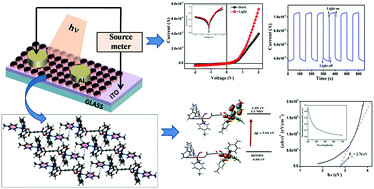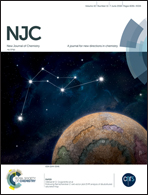Cu(ii)-Based binuclear compound for the application of photosensitive electronic devices†
Abstract
In this study, an acetylenedicarboxylate based binuclear Cu(II) compound [Cu2(adc)(4-pic)6(H2O)4][ClO4]2 (1) (H2adc = acetylenedicarboxylic acid and 4-pic = 4-picolene) has been synthesized and well characterized using elemental analysis, infrared (IR) spectra, thermogravimetric analysis (TGA), powder X-ray diffraction (PXRD) patterns and single crystal X-ray diffraction (SCXRD) techniques. The binuclear compound undergoes hydrogen bonding interactions to form a 1D hydrogen bonded aggregate, which further undergoes extensive edge-to-face C–H⋯π interactions to form a 3D supramolecular motif. The current conductivity of compound 1 was recorded under dark and illuminated conditions. Interestingly, the measured I–V characteristics of the synthesized material in the dark and under the illumination of incident light exhibit a highly non-linear rectifying behavior signifying a Schottky diode nature. Furthermore, the enhancement of values of the electrical parameters after exposure to illumination of incident radiation indicates the light sensing behaviour of the material. Therefore, the material can be used as a promising candidate in photosensitive electronic devices.



 Please wait while we load your content...
Please wait while we load your content...